CHCECE024 & CHCECE022: Curriculum Design and Children's Learning | Desklib
VerifiedAdded on 2023/06/03
|14
|3345
|138
AI Summary
CHCECE024 and CHCECE022 units focus on designing and implementing curriculum to foster children's learning and development and promoting children's agency. The assessment tasks within these units provide an opportunity to demonstrate evidence of the knowledge and skills required. Get study material, solved assignments, essays, and dissertations on Desklib.
Contribute Materials
Your contribution can guide someone’s learning journey. Share your
documents today.
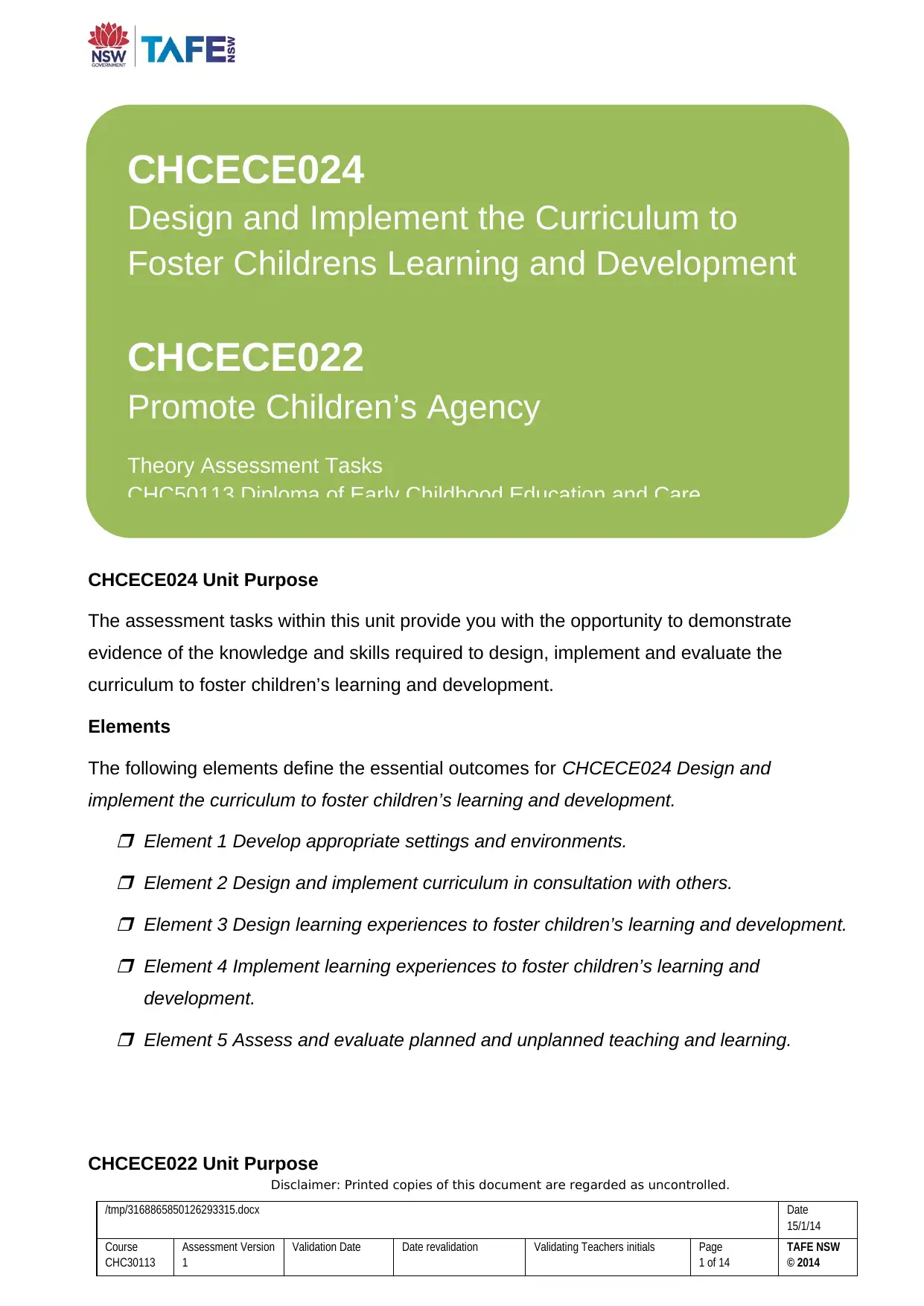
CHCECE024 Unit Purpose
The assessment tasks within this unit provide you with the opportunity to demonstrate
evidence of the knowledge and skills required to design, implement and evaluate the
curriculum to foster children’s learning and development.
Elements
The following elements define the essential outcomes for CHCECE024 Design and
implement the curriculum to foster children’s learning and development.
Element 1 Develop appropriate settings and environments.
Element 2 Design and implement curriculum in consultation with others.
Element 3 Design learning experiences to foster children’s learning and development.
Element 4 Implement learning experiences to foster children’s learning and
development.
Element 5 Assess and evaluate planned and unplanned teaching and learning.
CHCECE022 Unit Purpose
Disclaimer: Printed copies of this document are regarded as uncontrolled.
/tmp/3168865850126293315.docx Date
15/1/14
Course
CHC30113
Assessment Version
1
Validation Date Date revalidation Validating Teachers initials Page
1 of 14
TAFE NSW
© 2014
CHCECE024
Design and Implement the Curriculum to
Foster Childrens Learning and Development
CHCECE022
Promote Children’s Agency
Theory Assessment Tasks
CHC50113 Diploma of Early Childhood Education and Care
The assessment tasks within this unit provide you with the opportunity to demonstrate
evidence of the knowledge and skills required to design, implement and evaluate the
curriculum to foster children’s learning and development.
Elements
The following elements define the essential outcomes for CHCECE024 Design and
implement the curriculum to foster children’s learning and development.
Element 1 Develop appropriate settings and environments.
Element 2 Design and implement curriculum in consultation with others.
Element 3 Design learning experiences to foster children’s learning and development.
Element 4 Implement learning experiences to foster children’s learning and
development.
Element 5 Assess and evaluate planned and unplanned teaching and learning.
CHCECE022 Unit Purpose
Disclaimer: Printed copies of this document are regarded as uncontrolled.
/tmp/3168865850126293315.docx Date
15/1/14
Course
CHC30113
Assessment Version
1
Validation Date Date revalidation Validating Teachers initials Page
1 of 14
TAFE NSW
© 2014
CHCECE024
Design and Implement the Curriculum to
Foster Childrens Learning and Development
CHCECE022
Promote Children’s Agency
Theory Assessment Tasks
CHC50113 Diploma of Early Childhood Education and Care
Secure Best Marks with AI Grader
Need help grading? Try our AI Grader for instant feedback on your assignments.
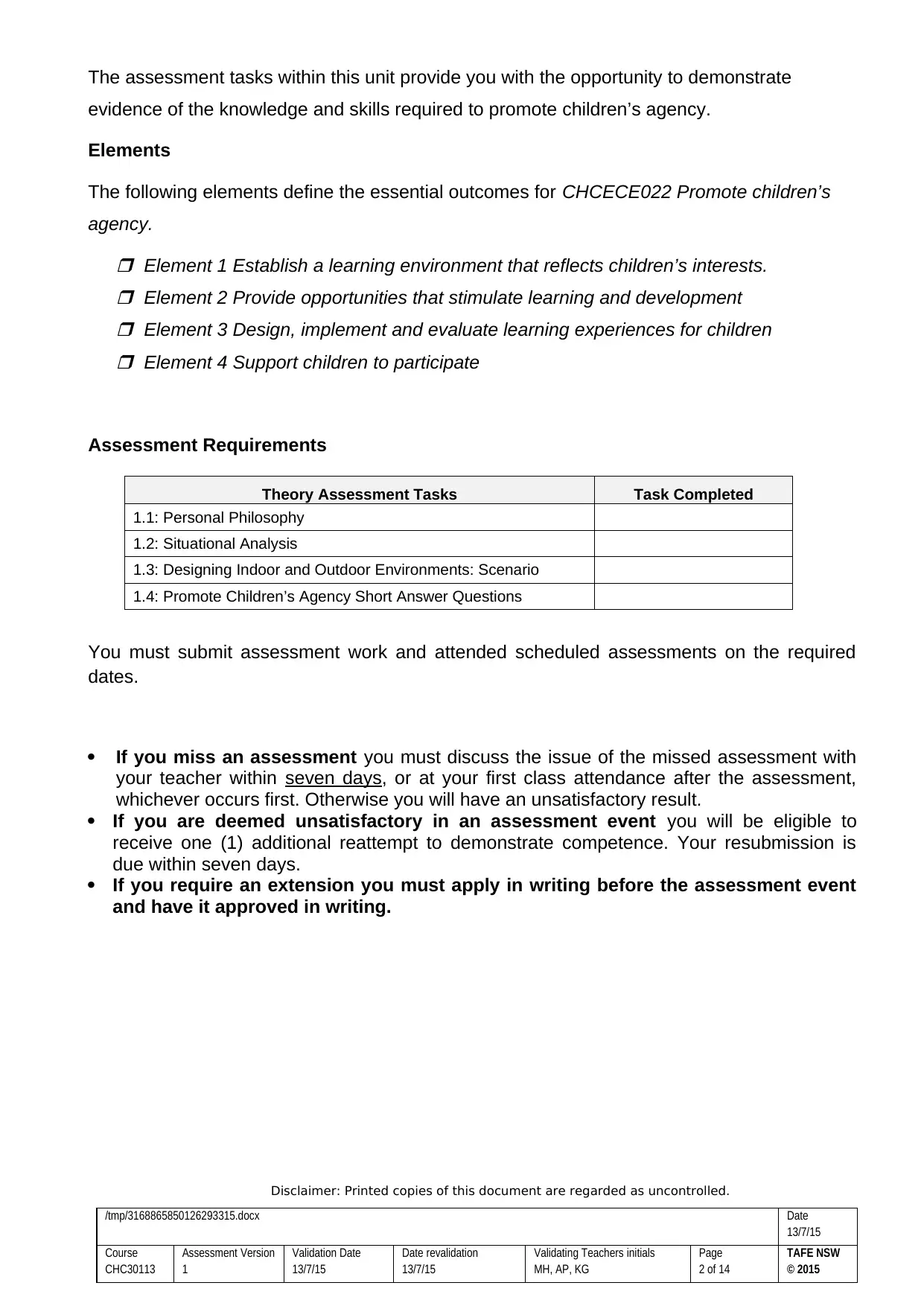
The assessment tasks within this unit provide you with the opportunity to demonstrate
evidence of the knowledge and skills required to promote children’s agency.
Elements
The following elements define the essential outcomes for CHCECE022 Promote children’s
agency.
Element 1 Establish a learning environment that reflects children’s interests. Element 2 Provide opportunities that stimulate learning and development Element 3 Design, implement and evaluate learning experiences for children Element 4 Support children to participate
Assessment Requirements
You must submit assessment work and attended scheduled assessments on the required
dates.
If you miss an assessment you must discuss the issue of the missed assessment with
your teacher within seven days, or at your first class attendance after the assessment,
whichever occurs first. Otherwise you will have an unsatisfactory result.
If you are deemed unsatisfactory in an assessment event you will be eligible to
receive one (1) additional reattempt to demonstrate competence. Your resubmission is
due within seven days.
If you require an extension you must apply in writing before the assessment event
and have it approved in writing.
Disclaimer: Printed copies of this document are regarded as uncontrolled.
/tmp/3168865850126293315.docx Date
13/7/15
Course
CHC30113
Assessment Version
1
Validation Date
13/7/15
Date revalidation
13/7/15
Validating Teachers initials
MH, AP, KG
Page
2 of 14
TAFE NSW
© 2015
Theory Assessment Tasks Task Completed
1.1: Personal Philosophy
1.2: Situational Analysis
1.3: Designing Indoor and Outdoor Environments: Scenario
1.4: Promote Children’s Agency Short Answer Questions
evidence of the knowledge and skills required to promote children’s agency.
Elements
The following elements define the essential outcomes for CHCECE022 Promote children’s
agency.
Element 1 Establish a learning environment that reflects children’s interests. Element 2 Provide opportunities that stimulate learning and development Element 3 Design, implement and evaluate learning experiences for children Element 4 Support children to participate
Assessment Requirements
You must submit assessment work and attended scheduled assessments on the required
dates.
If you miss an assessment you must discuss the issue of the missed assessment with
your teacher within seven days, or at your first class attendance after the assessment,
whichever occurs first. Otherwise you will have an unsatisfactory result.
If you are deemed unsatisfactory in an assessment event you will be eligible to
receive one (1) additional reattempt to demonstrate competence. Your resubmission is
due within seven days.
If you require an extension you must apply in writing before the assessment event
and have it approved in writing.
Disclaimer: Printed copies of this document are regarded as uncontrolled.
/tmp/3168865850126293315.docx Date
13/7/15
Course
CHC30113
Assessment Version
1
Validation Date
13/7/15
Date revalidation
13/7/15
Validating Teachers initials
MH, AP, KG
Page
2 of 14
TAFE NSW
© 2015
Theory Assessment Tasks Task Completed
1.1: Personal Philosophy
1.2: Situational Analysis
1.3: Designing Indoor and Outdoor Environments: Scenario
1.4: Promote Children’s Agency Short Answer Questions
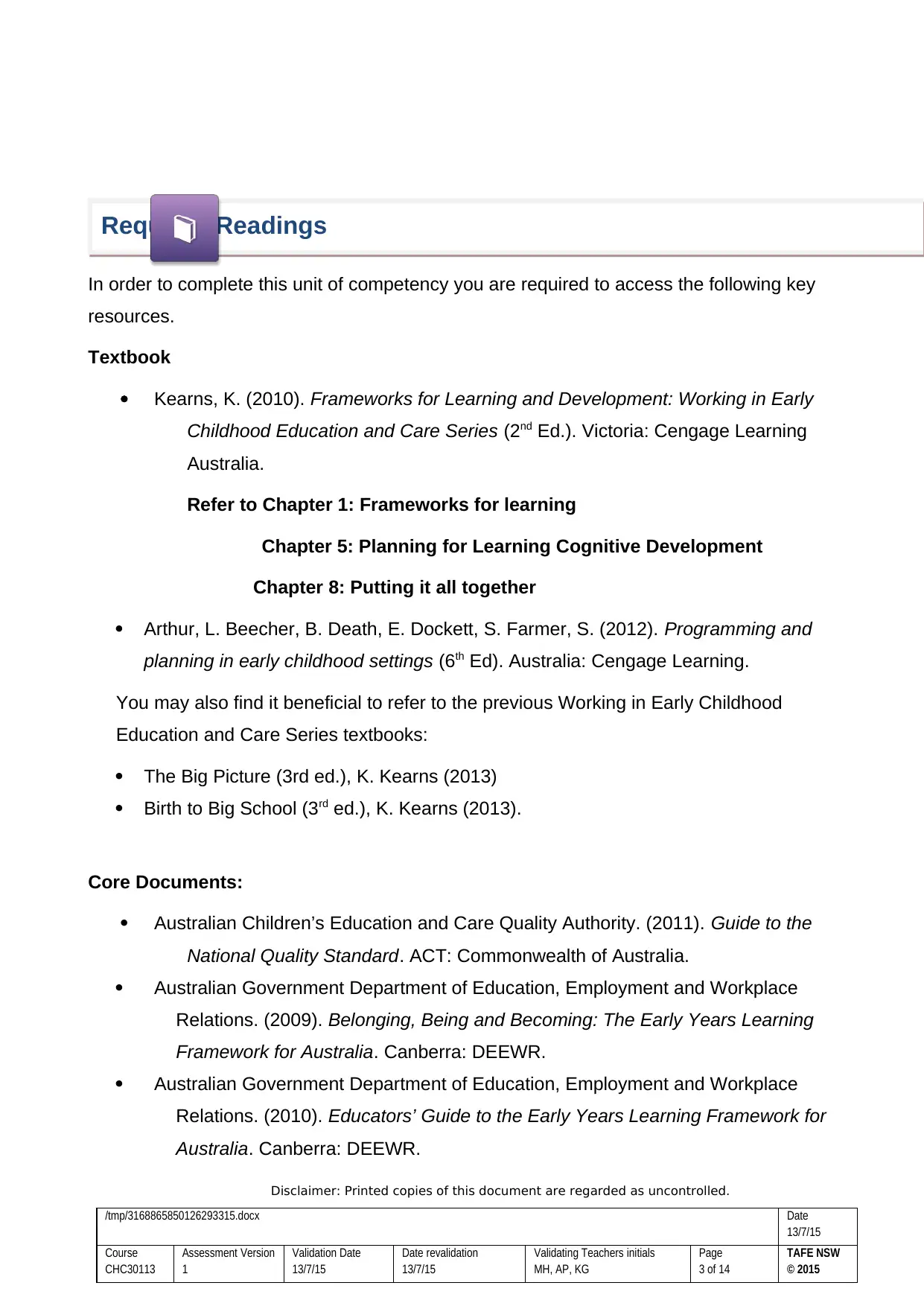
In order to complete this unit of competency you are required to access the following key
resources.
Textbook
Kearns, K. (2010). Frameworks for Learning and Development: Working in Early
Childhood Education and Care Series (2nd Ed.). Victoria: Cengage Learning
Australia.
Refer to Chapter 1: Frameworks for learning
Chapter 5: Planning for Learning Cognitive Development
Chapter 8: Putting it all together
Arthur, L. Beecher, B. Death, E. Dockett, S. Farmer, S. (2012). Programming and
planning in early childhood settings (6th Ed). Australia: Cengage Learning.
You may also find it beneficial to refer to the previous Working in Early Childhood
Education and Care Series textbooks:
The Big Picture (3rd ed.), K. Kearns (2013)
Birth to Big School (3rd ed.), K. Kearns (2013).
Core Documents:
Australian Children’s Education and Care Quality Authority. (2011). Guide to the
National Quality Standard. ACT: Commonwealth of Australia.
Australian Government Department of Education, Employment and Workplace
Relations. (2009). Belonging, Being and Becoming: The Early Years Learning
Framework for Australia. Canberra: DEEWR.
Australian Government Department of Education, Employment and Workplace
Relations. (2010). Educators’ Guide to the Early Years Learning Framework for
Australia. Canberra: DEEWR.
Disclaimer: Printed copies of this document are regarded as uncontrolled.
/tmp/3168865850126293315.docx Date
13/7/15
Course
CHC30113
Assessment Version
1
Validation Date
13/7/15
Date revalidation
13/7/15
Validating Teachers initials
MH, AP, KG
Page
3 of 14
TAFE NSW
© 2015
Required Readings
resources.
Textbook
Kearns, K. (2010). Frameworks for Learning and Development: Working in Early
Childhood Education and Care Series (2nd Ed.). Victoria: Cengage Learning
Australia.
Refer to Chapter 1: Frameworks for learning
Chapter 5: Planning for Learning Cognitive Development
Chapter 8: Putting it all together
Arthur, L. Beecher, B. Death, E. Dockett, S. Farmer, S. (2012). Programming and
planning in early childhood settings (6th Ed). Australia: Cengage Learning.
You may also find it beneficial to refer to the previous Working in Early Childhood
Education and Care Series textbooks:
The Big Picture (3rd ed.), K. Kearns (2013)
Birth to Big School (3rd ed.), K. Kearns (2013).
Core Documents:
Australian Children’s Education and Care Quality Authority. (2011). Guide to the
National Quality Standard. ACT: Commonwealth of Australia.
Australian Government Department of Education, Employment and Workplace
Relations. (2009). Belonging, Being and Becoming: The Early Years Learning
Framework for Australia. Canberra: DEEWR.
Australian Government Department of Education, Employment and Workplace
Relations. (2010). Educators’ Guide to the Early Years Learning Framework for
Australia. Canberra: DEEWR.
Disclaimer: Printed copies of this document are regarded as uncontrolled.
/tmp/3168865850126293315.docx Date
13/7/15
Course
CHC30113
Assessment Version
1
Validation Date
13/7/15
Date revalidation
13/7/15
Validating Teachers initials
MH, AP, KG
Page
3 of 14
TAFE NSW
© 2015
Required Readings
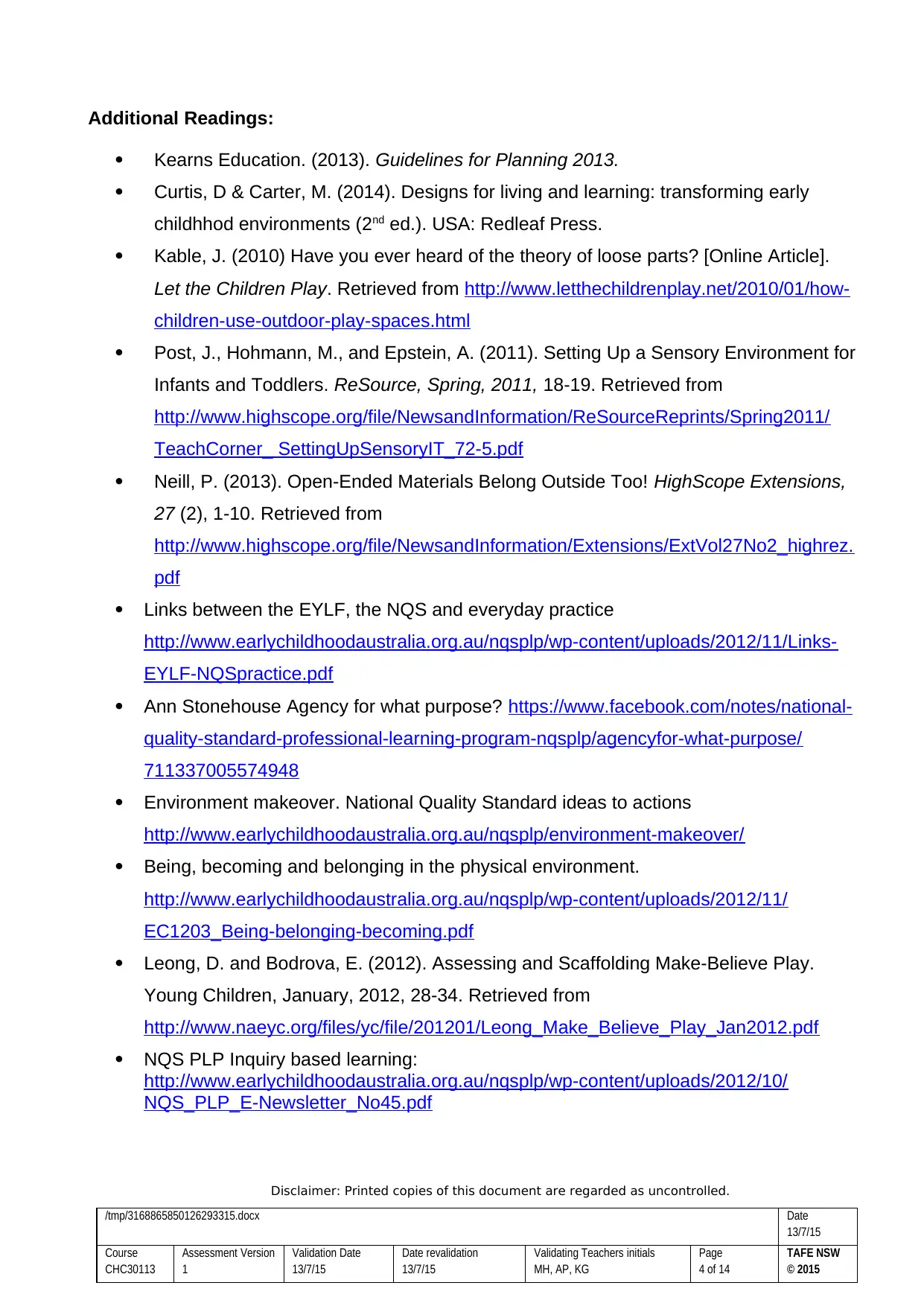
Additional Readings:
Kearns Education. (2013). Guidelines for Planning 2013.
Curtis, D & Carter, M. (2014). Designs for living and learning: transforming early
childhhod environments (2nd ed.). USA: Redleaf Press.
Kable, J. (2010) Have you ever heard of the theory of loose parts? [Online Article].
Let the Children Play. Retrieved from http://www.letthechildrenplay.net/2010/01/how-
children-use-outdoor-play-spaces.html
Post, J., Hohmann, M., and Epstein, A. (2011). Setting Up a Sensory Environment for
Infants and Toddlers. ReSource, Spring, 2011, 18-19. Retrieved from
http://www.highscope.org/file/NewsandInformation/ReSourceReprints/Spring2011/
TeachCorner_ SettingUpSensoryIT_72-5.pdf
Neill, P. (2013). Open-Ended Materials Belong Outside Too! HighScope Extensions,
27 (2), 1-10. Retrieved from
http://www.highscope.org/file/NewsandInformation/Extensions/ExtVol27No2_highrez.
pdf
Links between the EYLF, the NQS and everyday practice
http://www.earlychildhoodaustralia.org.au/nqsplp/wp-content/uploads/2012/11/Links-
EYLF-NQSpractice.pdf
Ann Stonehouse Agency for what purpose? https://www.facebook.com/notes/national-
quality-standard-professional-learning-program-nqsplp/agencyfor-what-purpose/
711337005574948
Environment makeover. National Quality Standard ideas to actions
http://www.earlychildhoodaustralia.org.au/nqsplp/environment-makeover/
Being, becoming and belonging in the physical environment.
http://www.earlychildhoodaustralia.org.au/nqsplp/wp-content/uploads/2012/11/
EC1203_Being-belonging-becoming.pdf
Leong, D. and Bodrova, E. (2012). Assessing and Scaffolding Make-Believe Play.
Young Children, January, 2012, 28-34. Retrieved from
http://www.naeyc.org/files/yc/file/201201/Leong_Make_Believe_Play_Jan2012.pdf
NQS PLP Inquiry based learning:
http://www.earlychildhoodaustralia.org.au/nqsplp/wp-content/uploads/2012/10/
NQS_PLP_E-Newsletter_No45.pdf
Disclaimer: Printed copies of this document are regarded as uncontrolled.
/tmp/3168865850126293315.docx Date
13/7/15
Course
CHC30113
Assessment Version
1
Validation Date
13/7/15
Date revalidation
13/7/15
Validating Teachers initials
MH, AP, KG
Page
4 of 14
TAFE NSW
© 2015
Kearns Education. (2013). Guidelines for Planning 2013.
Curtis, D & Carter, M. (2014). Designs for living and learning: transforming early
childhhod environments (2nd ed.). USA: Redleaf Press.
Kable, J. (2010) Have you ever heard of the theory of loose parts? [Online Article].
Let the Children Play. Retrieved from http://www.letthechildrenplay.net/2010/01/how-
children-use-outdoor-play-spaces.html
Post, J., Hohmann, M., and Epstein, A. (2011). Setting Up a Sensory Environment for
Infants and Toddlers. ReSource, Spring, 2011, 18-19. Retrieved from
http://www.highscope.org/file/NewsandInformation/ReSourceReprints/Spring2011/
TeachCorner_ SettingUpSensoryIT_72-5.pdf
Neill, P. (2013). Open-Ended Materials Belong Outside Too! HighScope Extensions,
27 (2), 1-10. Retrieved from
http://www.highscope.org/file/NewsandInformation/Extensions/ExtVol27No2_highrez.
Links between the EYLF, the NQS and everyday practice
http://www.earlychildhoodaustralia.org.au/nqsplp/wp-content/uploads/2012/11/Links-
EYLF-NQSpractice.pdf
Ann Stonehouse Agency for what purpose? https://www.facebook.com/notes/national-
quality-standard-professional-learning-program-nqsplp/agencyfor-what-purpose/
711337005574948
Environment makeover. National Quality Standard ideas to actions
http://www.earlychildhoodaustralia.org.au/nqsplp/environment-makeover/
Being, becoming and belonging in the physical environment.
http://www.earlychildhoodaustralia.org.au/nqsplp/wp-content/uploads/2012/11/
EC1203_Being-belonging-becoming.pdf
Leong, D. and Bodrova, E. (2012). Assessing and Scaffolding Make-Believe Play.
Young Children, January, 2012, 28-34. Retrieved from
http://www.naeyc.org/files/yc/file/201201/Leong_Make_Believe_Play_Jan2012.pdf
NQS PLP Inquiry based learning:
http://www.earlychildhoodaustralia.org.au/nqsplp/wp-content/uploads/2012/10/
NQS_PLP_E-Newsletter_No45.pdf
Disclaimer: Printed copies of this document are regarded as uncontrolled.
/tmp/3168865850126293315.docx Date
13/7/15
Course
CHC30113
Assessment Version
1
Validation Date
13/7/15
Date revalidation
13/7/15
Validating Teachers initials
MH, AP, KG
Page
4 of 14
TAFE NSW
© 2015
Secure Best Marks with AI Grader
Need help grading? Try our AI Grader for instant feedback on your assignments.
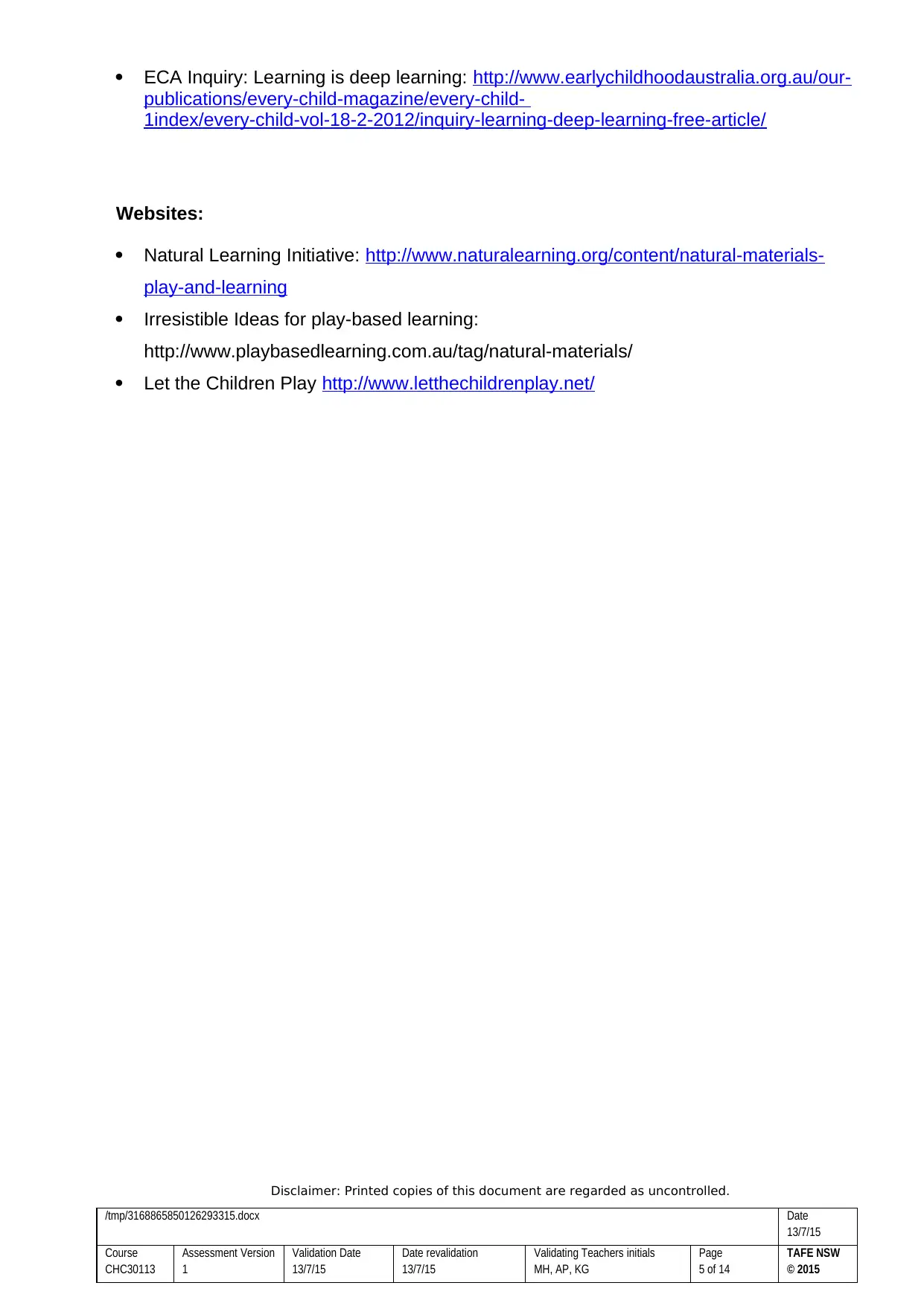
ECA Inquiry: Learning is deep learning: http://www.earlychildhoodaustralia.org.au/our-
publications/every-child-magazine/every-child-
1index/every-child-vol-18-2-2012/inquiry-learning-deep-learning-free-article/
Websites:
Natural Learning Initiative: http://www.naturalearning.org/content/natural-materials-
play-and-learning
Irresistible Ideas for play-based learning:
http://www.playbasedlearning.com.au/tag/natural-materials/
Let the Children Play http://www.letthechildrenplay.net/
Disclaimer: Printed copies of this document are regarded as uncontrolled.
/tmp/3168865850126293315.docx Date
13/7/15
Course
CHC30113
Assessment Version
1
Validation Date
13/7/15
Date revalidation
13/7/15
Validating Teachers initials
MH, AP, KG
Page
5 of 14
TAFE NSW
© 2015
publications/every-child-magazine/every-child-
1index/every-child-vol-18-2-2012/inquiry-learning-deep-learning-free-article/
Websites:
Natural Learning Initiative: http://www.naturalearning.org/content/natural-materials-
play-and-learning
Irresistible Ideas for play-based learning:
http://www.playbasedlearning.com.au/tag/natural-materials/
Let the Children Play http://www.letthechildrenplay.net/
Disclaimer: Printed copies of this document are regarded as uncontrolled.
/tmp/3168865850126293315.docx Date
13/7/15
Course
CHC30113
Assessment Version
1
Validation Date
13/7/15
Date revalidation
13/7/15
Validating Teachers initials
MH, AP, KG
Page
5 of 14
TAFE NSW
© 2015
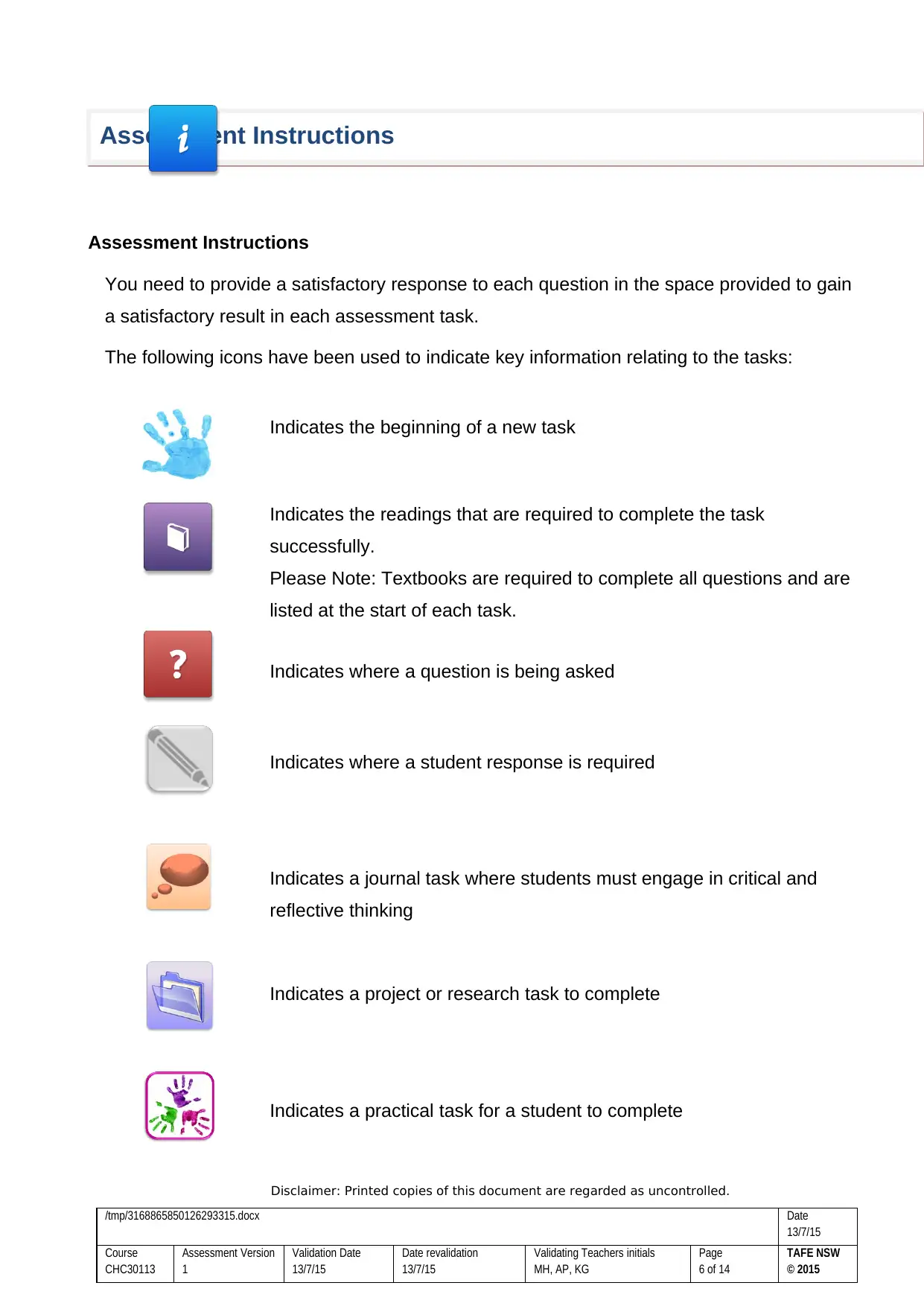
Assessment Instructions
You need to provide a satisfactory response to each question in the space provided to gain
a satisfactory result in each assessment task.
The following icons have been used to indicate key information relating to the tasks:
Indicates the beginning of a new task
Indicates the readings that are required to complete the task
successfully.
Please Note: Textbooks are required to complete all questions and are
listed at the start of each task.
Indicates where a question is being asked
Indicates where a student response is required
Indicates a journal task where students must engage in critical and
reflective thinking
Indicates a project or research task to complete
Indicates a practical task for a student to complete
Disclaimer: Printed copies of this document are regarded as uncontrolled.
/tmp/3168865850126293315.docx Date
13/7/15
Course
CHC30113
Assessment Version
1
Validation Date
13/7/15
Date revalidation
13/7/15
Validating Teachers initials
MH, AP, KG
Page
6 of 14
TAFE NSW
© 2015
Assessment Instructions
You need to provide a satisfactory response to each question in the space provided to gain
a satisfactory result in each assessment task.
The following icons have been used to indicate key information relating to the tasks:
Indicates the beginning of a new task
Indicates the readings that are required to complete the task
successfully.
Please Note: Textbooks are required to complete all questions and are
listed at the start of each task.
Indicates where a question is being asked
Indicates where a student response is required
Indicates a journal task where students must engage in critical and
reflective thinking
Indicates a project or research task to complete
Indicates a practical task for a student to complete
Disclaimer: Printed copies of this document are regarded as uncontrolled.
/tmp/3168865850126293315.docx Date
13/7/15
Course
CHC30113
Assessment Version
1
Validation Date
13/7/15
Date revalidation
13/7/15
Validating Teachers initials
MH, AP, KG
Page
6 of 14
TAFE NSW
© 2015
Assessment Instructions

Disclaimer: Printed copies of this document are regarded as uncontrolled.
/tmp/3168865850126293315.docx Date
13/7/15
Course
CHC30113
Assessment Version
1
Validation Date
13/7/15
Date revalidation
13/7/15
Validating Teachers initials
MH, AP, KG
Page
7 of 14
TAFE NSW
© 2015
/tmp/3168865850126293315.docx Date
13/7/15
Course
CHC30113
Assessment Version
1
Validation Date
13/7/15
Date revalidation
13/7/15
Validating Teachers initials
MH, AP, KG
Page
7 of 14
TAFE NSW
© 2015
Paraphrase This Document
Need a fresh take? Get an instant paraphrase of this document with our AI Paraphraser
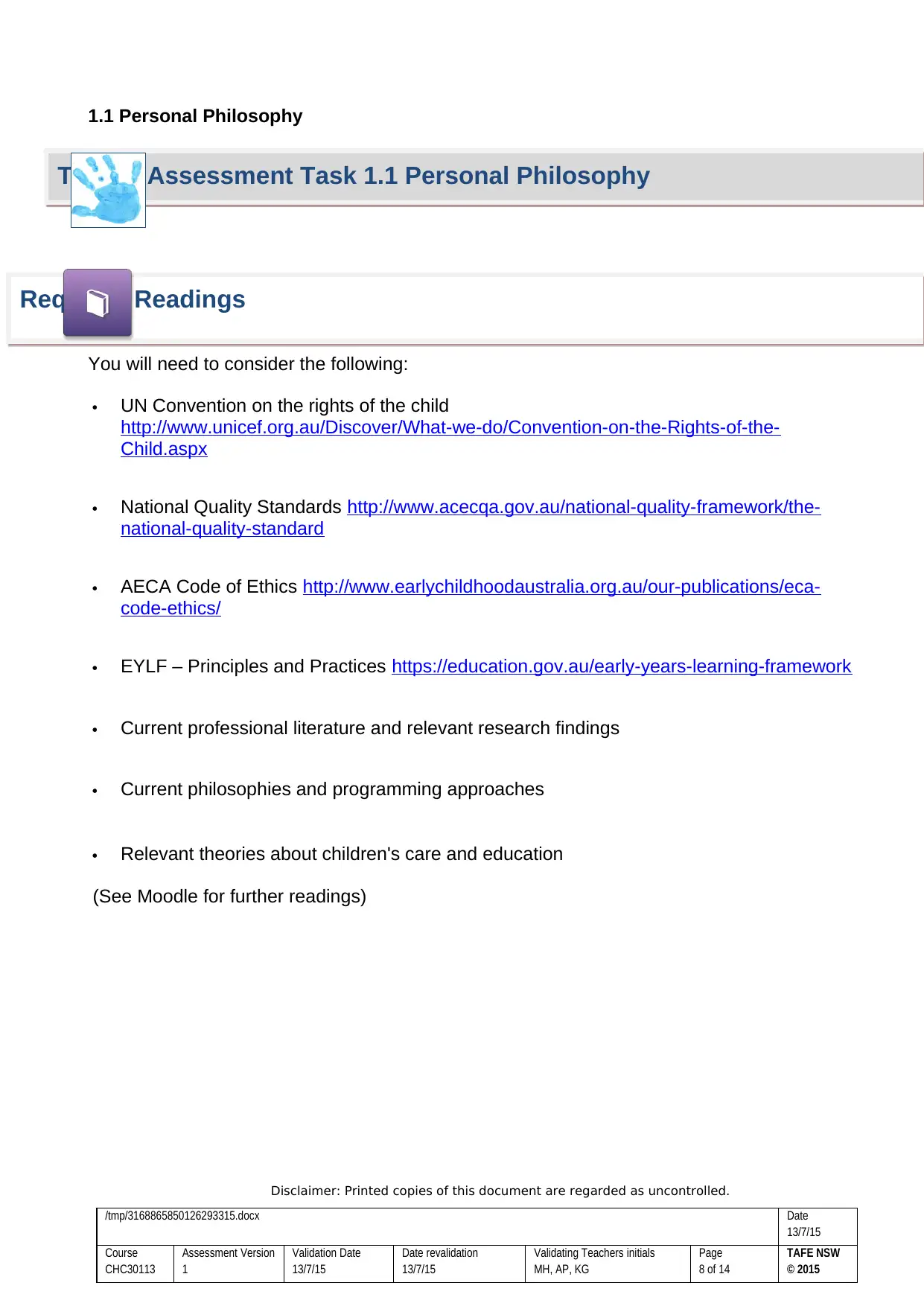
1.1 Personal Philosophy
You will need to consider the following:
UN Convention on the rights of the child
http://www.unicef.org.au/Discover/What-we-do/Convention-on-the-Rights-of-the-
Child.aspx
National Quality Standards http://www.acecqa.gov.au/national-quality-framework/the-
national-quality-standard
AECA Code of Ethics http://www.earlychildhoodaustralia.org.au/our-publications/eca-
code-ethics/
EYLF – Principles and Practices https://education.gov.au/early-years-learning-framework
Current professional literature and relevant research findings
Current philosophies and programming approaches
Relevant theories about children's care and education
(See Moodle for further readings)
Disclaimer: Printed copies of this document are regarded as uncontrolled.
/tmp/3168865850126293315.docx Date
13/7/15
Course
CHC30113
Assessment Version
1
Validation Date
13/7/15
Date revalidation
13/7/15
Validating Teachers initials
MH, AP, KG
Page
8 of 14
TAFE NSW
© 2015
Theory Assessment Task 1.1 Personal Philosophy
Required Readings
You will need to consider the following:
UN Convention on the rights of the child
http://www.unicef.org.au/Discover/What-we-do/Convention-on-the-Rights-of-the-
Child.aspx
National Quality Standards http://www.acecqa.gov.au/national-quality-framework/the-
national-quality-standard
AECA Code of Ethics http://www.earlychildhoodaustralia.org.au/our-publications/eca-
code-ethics/
EYLF – Principles and Practices https://education.gov.au/early-years-learning-framework
Current professional literature and relevant research findings
Current philosophies and programming approaches
Relevant theories about children's care and education
(See Moodle for further readings)
Disclaimer: Printed copies of this document are regarded as uncontrolled.
/tmp/3168865850126293315.docx Date
13/7/15
Course
CHC30113
Assessment Version
1
Validation Date
13/7/15
Date revalidation
13/7/15
Validating Teachers initials
MH, AP, KG
Page
8 of 14
TAFE NSW
© 2015
Theory Assessment Task 1.1 Personal Philosophy
Required Readings
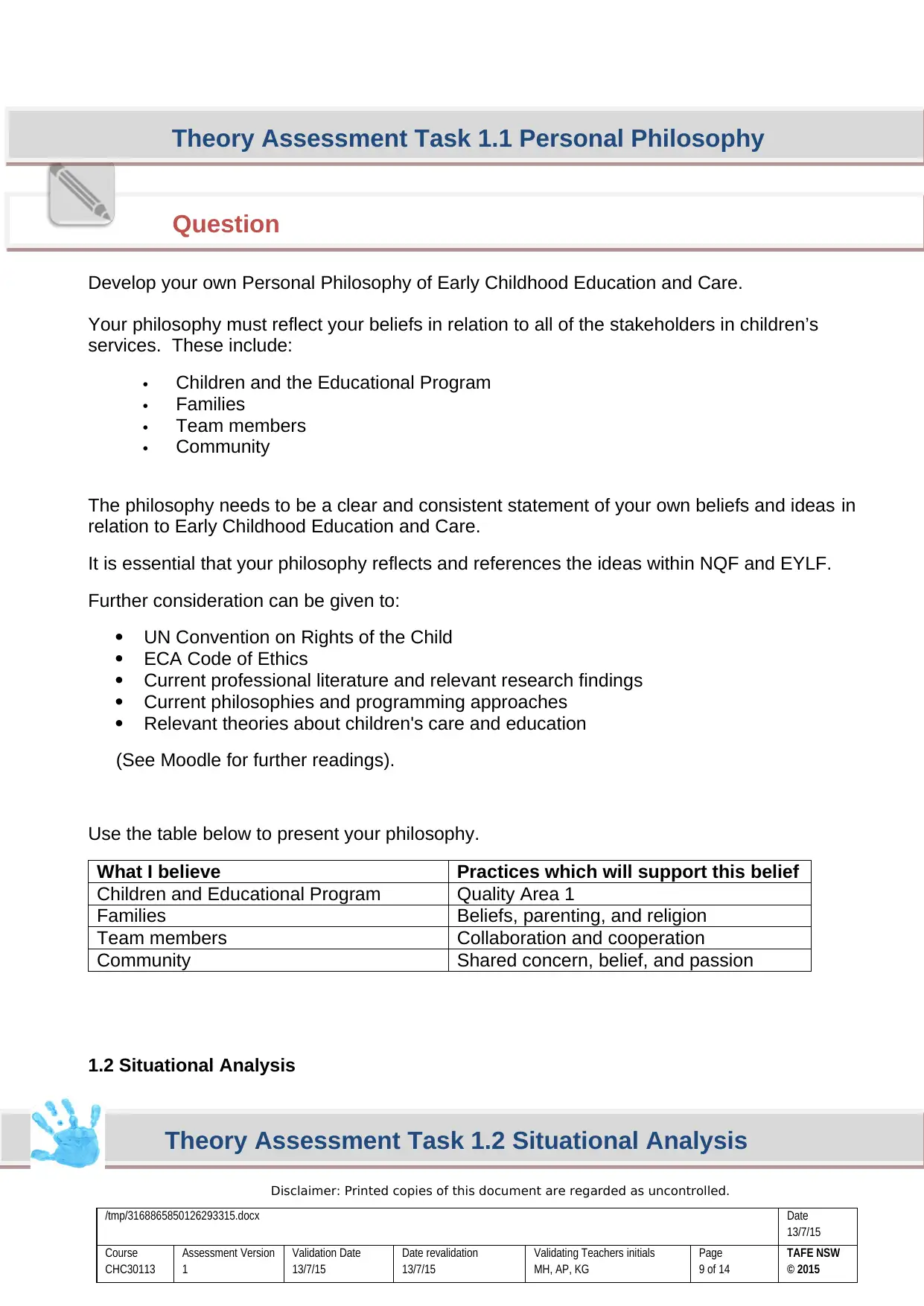
Develop your own Personal Philosophy of Early Childhood Education and Care.
Your philosophy must reflect your beliefs in relation to all of the stakeholders in children’s
services. These include:
Children and the Educational Program
Families
Team members
Community
The philosophy needs to be a clear and consistent statement of your own beliefs and ideas in
relation to Early Childhood Education and Care.
It is essential that your philosophy reflects and references the ideas within NQF and EYLF.
Further consideration can be given to:
UN Convention on Rights of the Child
ECA Code of Ethics
Current professional literature and relevant research findings
Current philosophies and programming approaches
Relevant theories about children's care and education
(See Moodle for further readings).
Use the table below to present your philosophy.
What I believe Practices which will support this belief
Children and Educational Program Quality Area 1
Families Beliefs, parenting, and religion
Team members Collaboration and cooperation
Community Shared concern, belief, and passion
1.2 Situational Analysis
Disclaimer: Printed copies of this document are regarded as uncontrolled.
/tmp/3168865850126293315.docx Date
13/7/15
Course
CHC30113
Assessment Version
1
Validation Date
13/7/15
Date revalidation
13/7/15
Validating Teachers initials
MH, AP, KG
Page
9 of 14
TAFE NSW
© 2015
Question
Theory Assessment Task 1.2 Situational Analysis
Theory Assessment Task 1.1 Personal Philosophy
Your philosophy must reflect your beliefs in relation to all of the stakeholders in children’s
services. These include:
Children and the Educational Program
Families
Team members
Community
The philosophy needs to be a clear and consistent statement of your own beliefs and ideas in
relation to Early Childhood Education and Care.
It is essential that your philosophy reflects and references the ideas within NQF and EYLF.
Further consideration can be given to:
UN Convention on Rights of the Child
ECA Code of Ethics
Current professional literature and relevant research findings
Current philosophies and programming approaches
Relevant theories about children's care and education
(See Moodle for further readings).
Use the table below to present your philosophy.
What I believe Practices which will support this belief
Children and Educational Program Quality Area 1
Families Beliefs, parenting, and religion
Team members Collaboration and cooperation
Community Shared concern, belief, and passion
1.2 Situational Analysis
Disclaimer: Printed copies of this document are regarded as uncontrolled.
/tmp/3168865850126293315.docx Date
13/7/15
Course
CHC30113
Assessment Version
1
Validation Date
13/7/15
Date revalidation
13/7/15
Validating Teachers initials
MH, AP, KG
Page
9 of 14
TAFE NSW
© 2015
Question
Theory Assessment Task 1.2 Situational Analysis
Theory Assessment Task 1.1 Personal Philosophy
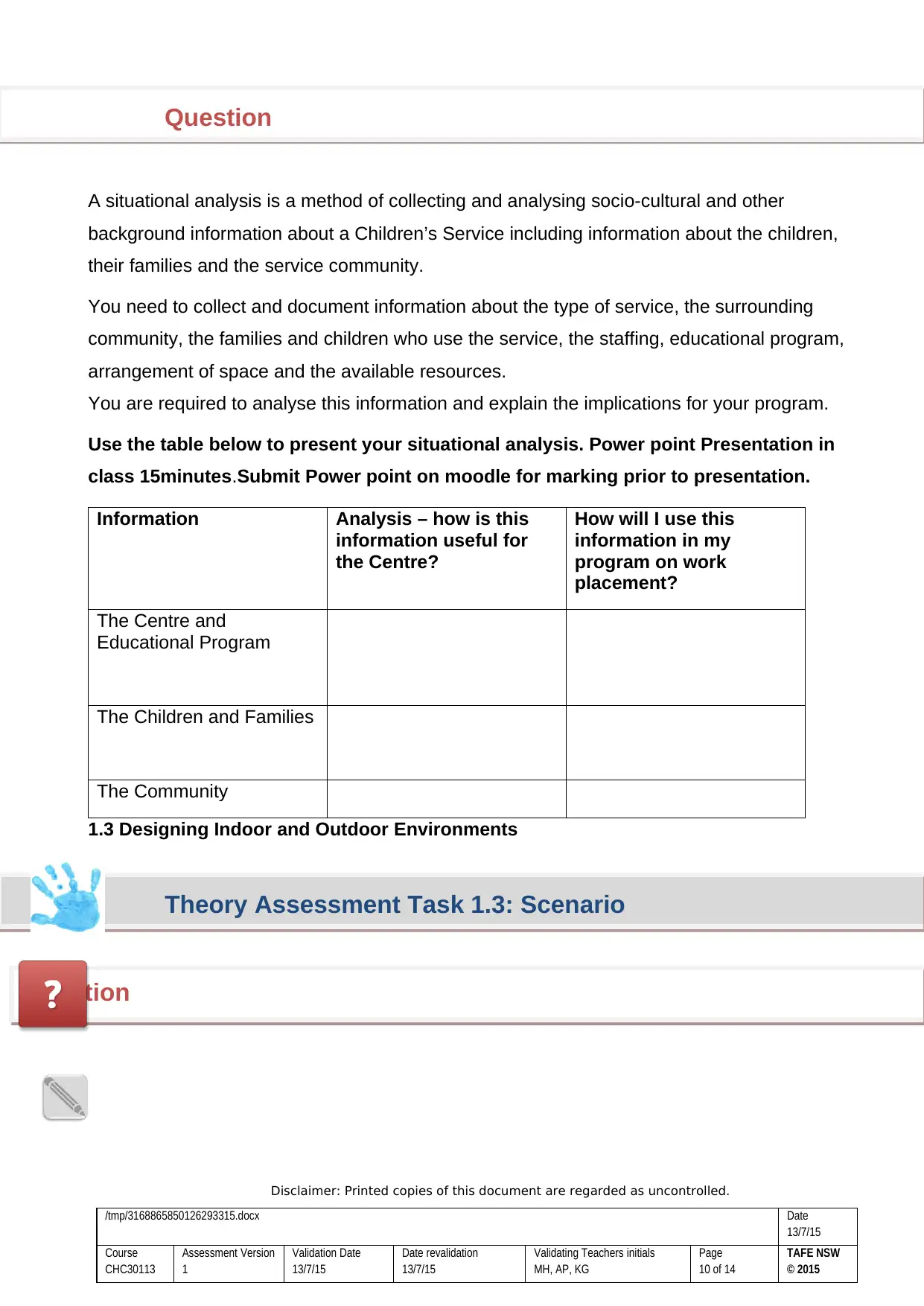
A situational analysis is a method of collecting and analysing socio-cultural and other
background information about a Children’s Service including information about the children,
their families and the service community.
You need to collect and document information about the type of service, the surrounding
community, the families and children who use the service, the staffing, educational program,
arrangement of space and the available resources.
You are required to analyse this information and explain the implications for your program.
Use the table below to present your situational analysis. Power point Presentation in
class 15minutes.Submit Power point on moodle for marking prior to presentation.
Information Analysis – how is this
information useful for
the Centre?
How will I use this
information in my
program on work
placement?
The Centre and
Educational Program
The Children and Families
The Community
1.3 Designing Indoor and Outdoor Environments
Disclaimer: Printed copies of this document are regarded as uncontrolled.
/tmp/3168865850126293315.docx Date
13/7/15
Course
CHC30113
Assessment Version
1
Validation Date
13/7/15
Date revalidation
13/7/15
Validating Teachers initials
MH, AP, KG
Page
10 of 14
TAFE NSW
© 2015
Question
Question
Theory Assessment Task 1.3: Scenario
background information about a Children’s Service including information about the children,
their families and the service community.
You need to collect and document information about the type of service, the surrounding
community, the families and children who use the service, the staffing, educational program,
arrangement of space and the available resources.
You are required to analyse this information and explain the implications for your program.
Use the table below to present your situational analysis. Power point Presentation in
class 15minutes.Submit Power point on moodle for marking prior to presentation.
Information Analysis – how is this
information useful for
the Centre?
How will I use this
information in my
program on work
placement?
The Centre and
Educational Program
The Children and Families
The Community
1.3 Designing Indoor and Outdoor Environments
Disclaimer: Printed copies of this document are regarded as uncontrolled.
/tmp/3168865850126293315.docx Date
13/7/15
Course
CHC30113
Assessment Version
1
Validation Date
13/7/15
Date revalidation
13/7/15
Validating Teachers initials
MH, AP, KG
Page
10 of 14
TAFE NSW
© 2015
Question
Question
Theory Assessment Task 1.3: Scenario
Secure Best Marks with AI Grader
Need help grading? Try our AI Grader for instant feedback on your assignments.
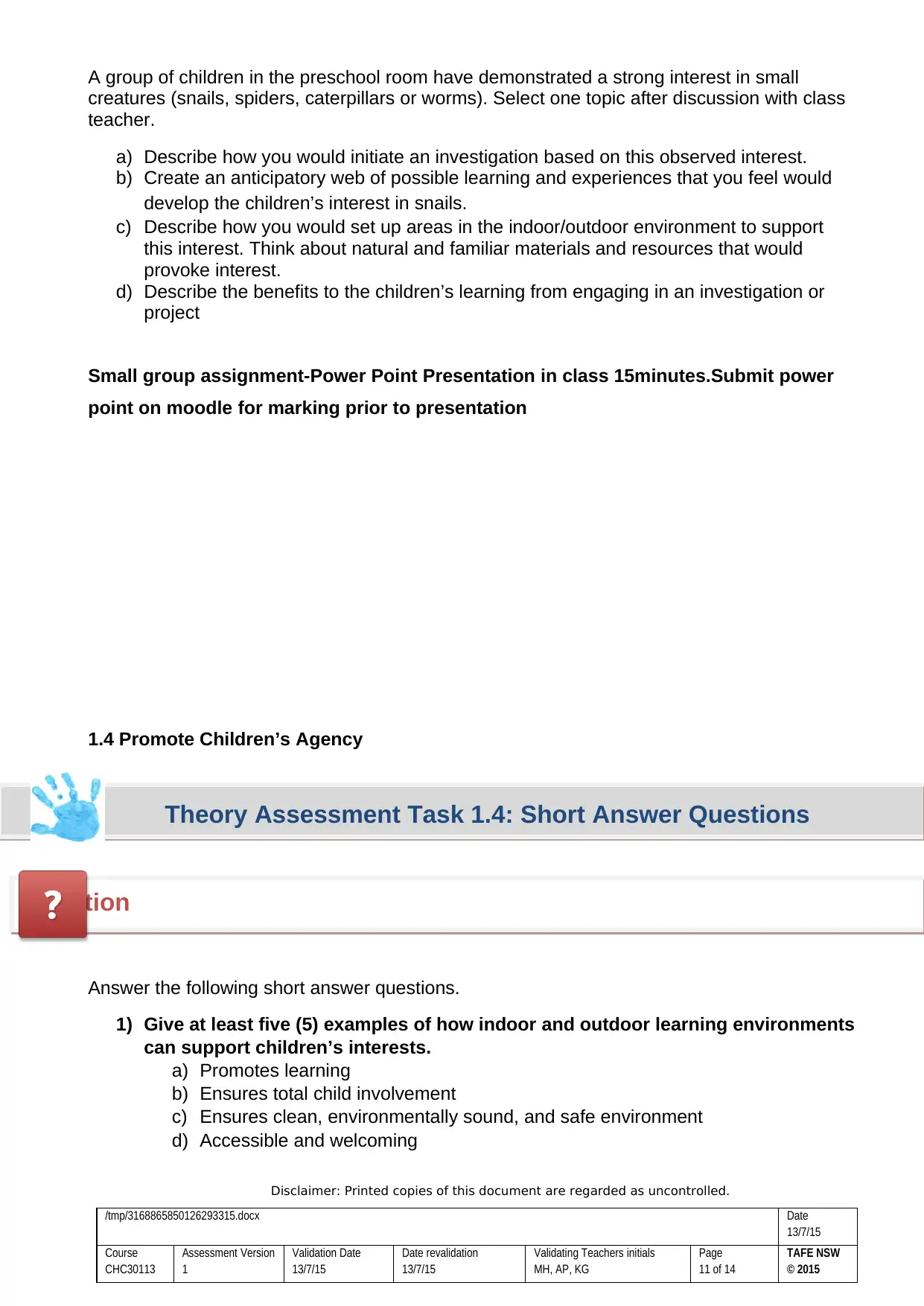
A group of children in the preschool room have demonstrated a strong interest in small
creatures (snails, spiders, caterpillars or worms). Select one topic after discussion with class
teacher.
a) Describe how you would initiate an investigation based on this observed interest.
b) Create an anticipatory web of possible learning and experiences that you feel would
develop the children’s interest in snails.
c) Describe how you would set up areas in the indoor/outdoor environment to support
this interest. Think about natural and familiar materials and resources that would
provoke interest.
d) Describe the benefits to the children’s learning from engaging in an investigation or
project
Small group assignment-Power Point Presentation in class 15minutes.Submit power
point on moodle for marking prior to presentation
1.4 Promote Children’s Agency
Answer the following short answer questions.
1) Give at least five (5) examples of how indoor and outdoor learning environments
can support children’s interests.
a) Promotes learning
b) Ensures total child involvement
c) Ensures clean, environmentally sound, and safe environment
d) Accessible and welcoming
Disclaimer: Printed copies of this document are regarded as uncontrolled.
/tmp/3168865850126293315.docx Date
13/7/15
Course
CHC30113
Assessment Version
1
Validation Date
13/7/15
Date revalidation
13/7/15
Validating Teachers initials
MH, AP, KG
Page
11 of 14
TAFE NSW
© 2015
Question
Theory Assessment Task 1.4: Short Answer Questions
creatures (snails, spiders, caterpillars or worms). Select one topic after discussion with class
teacher.
a) Describe how you would initiate an investigation based on this observed interest.
b) Create an anticipatory web of possible learning and experiences that you feel would
develop the children’s interest in snails.
c) Describe how you would set up areas in the indoor/outdoor environment to support
this interest. Think about natural and familiar materials and resources that would
provoke interest.
d) Describe the benefits to the children’s learning from engaging in an investigation or
project
Small group assignment-Power Point Presentation in class 15minutes.Submit power
point on moodle for marking prior to presentation
1.4 Promote Children’s Agency
Answer the following short answer questions.
1) Give at least five (5) examples of how indoor and outdoor learning environments
can support children’s interests.
a) Promotes learning
b) Ensures total child involvement
c) Ensures clean, environmentally sound, and safe environment
d) Accessible and welcoming
Disclaimer: Printed copies of this document are regarded as uncontrolled.
/tmp/3168865850126293315.docx Date
13/7/15
Course
CHC30113
Assessment Version
1
Validation Date
13/7/15
Date revalidation
13/7/15
Validating Teachers initials
MH, AP, KG
Page
11 of 14
TAFE NSW
© 2015
Question
Theory Assessment Task 1.4: Short Answer Questions
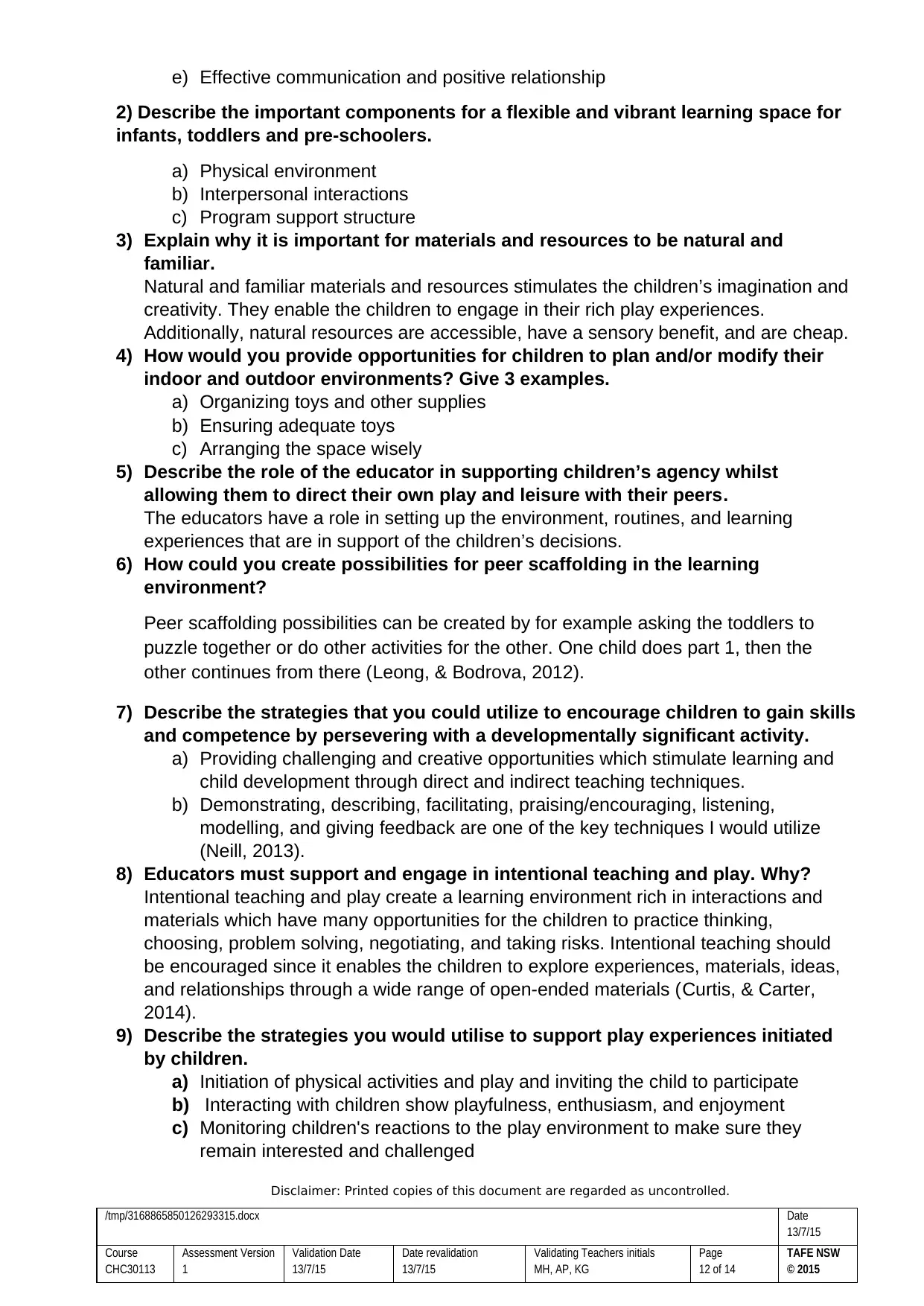
e) Effective communication and positive relationship
2) Describe the important components for a flexible and vibrant learning space for
infants, toddlers and pre-schoolers.
a) Physical environment
b) Interpersonal interactions
c) Program support structure
3) Explain why it is important for materials and resources to be natural and
familiar.
Natural and familiar materials and resources stimulates the children’s imagination and
creativity. They enable the children to engage in their rich play experiences.
Additionally, natural resources are accessible, have a sensory benefit, and are cheap.
4) How would you provide opportunities for children to plan and/or modify their
indoor and outdoor environments? Give 3 examples.
a) Organizing toys and other supplies
b) Ensuring adequate toys
c) Arranging the space wisely
5) Describe the role of the educator in supporting children’s agency whilst
allowing them to direct their own play and leisure with their peers.
The educators have a role in setting up the environment, routines, and learning
experiences that are in support of the children’s decisions.
6) How could you create possibilities for peer scaffolding in the learning
environment?
Peer scaffolding possibilities can be created by for example asking the toddlers to
puzzle together or do other activities for the other. One child does part 1, then the
other continues from there (Leong, & Bodrova, 2012).
7) Describe the strategies that you could utilize to encourage children to gain skills
and competence by persevering with a developmentally significant activity.
a) Providing challenging and creative opportunities which stimulate learning and
child development through direct and indirect teaching techniques.
b) Demonstrating, describing, facilitating, praising/encouraging, listening,
modelling, and giving feedback are one of the key techniques I would utilize
(Neill, 2013).
8) Educators must support and engage in intentional teaching and play. Why?
Intentional teaching and play create a learning environment rich in interactions and
materials which have many opportunities for the children to practice thinking,
choosing, problem solving, negotiating, and taking risks. Intentional teaching should
be encouraged since it enables the children to explore experiences, materials, ideas,
and relationships through a wide range of open-ended materials (Curtis, & Carter,
2014).
9) Describe the strategies you would utilise to support play experiences initiated
by children.
a) Initiation of physical activities and play and inviting the child to participate
b) Interacting with children show playfulness, enthusiasm, and enjoyment
c) Monitoring children's reactions to the play environment to make sure they
remain interested and challenged
Disclaimer: Printed copies of this document are regarded as uncontrolled.
/tmp/3168865850126293315.docx Date
13/7/15
Course
CHC30113
Assessment Version
1
Validation Date
13/7/15
Date revalidation
13/7/15
Validating Teachers initials
MH, AP, KG
Page
12 of 14
TAFE NSW
© 2015
2) Describe the important components for a flexible and vibrant learning space for
infants, toddlers and pre-schoolers.
a) Physical environment
b) Interpersonal interactions
c) Program support structure
3) Explain why it is important for materials and resources to be natural and
familiar.
Natural and familiar materials and resources stimulates the children’s imagination and
creativity. They enable the children to engage in their rich play experiences.
Additionally, natural resources are accessible, have a sensory benefit, and are cheap.
4) How would you provide opportunities for children to plan and/or modify their
indoor and outdoor environments? Give 3 examples.
a) Organizing toys and other supplies
b) Ensuring adequate toys
c) Arranging the space wisely
5) Describe the role of the educator in supporting children’s agency whilst
allowing them to direct their own play and leisure with their peers.
The educators have a role in setting up the environment, routines, and learning
experiences that are in support of the children’s decisions.
6) How could you create possibilities for peer scaffolding in the learning
environment?
Peer scaffolding possibilities can be created by for example asking the toddlers to
puzzle together or do other activities for the other. One child does part 1, then the
other continues from there (Leong, & Bodrova, 2012).
7) Describe the strategies that you could utilize to encourage children to gain skills
and competence by persevering with a developmentally significant activity.
a) Providing challenging and creative opportunities which stimulate learning and
child development through direct and indirect teaching techniques.
b) Demonstrating, describing, facilitating, praising/encouraging, listening,
modelling, and giving feedback are one of the key techniques I would utilize
(Neill, 2013).
8) Educators must support and engage in intentional teaching and play. Why?
Intentional teaching and play create a learning environment rich in interactions and
materials which have many opportunities for the children to practice thinking,
choosing, problem solving, negotiating, and taking risks. Intentional teaching should
be encouraged since it enables the children to explore experiences, materials, ideas,
and relationships through a wide range of open-ended materials (Curtis, & Carter,
2014).
9) Describe the strategies you would utilise to support play experiences initiated
by children.
a) Initiation of physical activities and play and inviting the child to participate
b) Interacting with children show playfulness, enthusiasm, and enjoyment
c) Monitoring children's reactions to the play environment to make sure they
remain interested and challenged
Disclaimer: Printed copies of this document are regarded as uncontrolled.
/tmp/3168865850126293315.docx Date
13/7/15
Course
CHC30113
Assessment Version
1
Validation Date
13/7/15
Date revalidation
13/7/15
Validating Teachers initials
MH, AP, KG
Page
12 of 14
TAFE NSW
© 2015
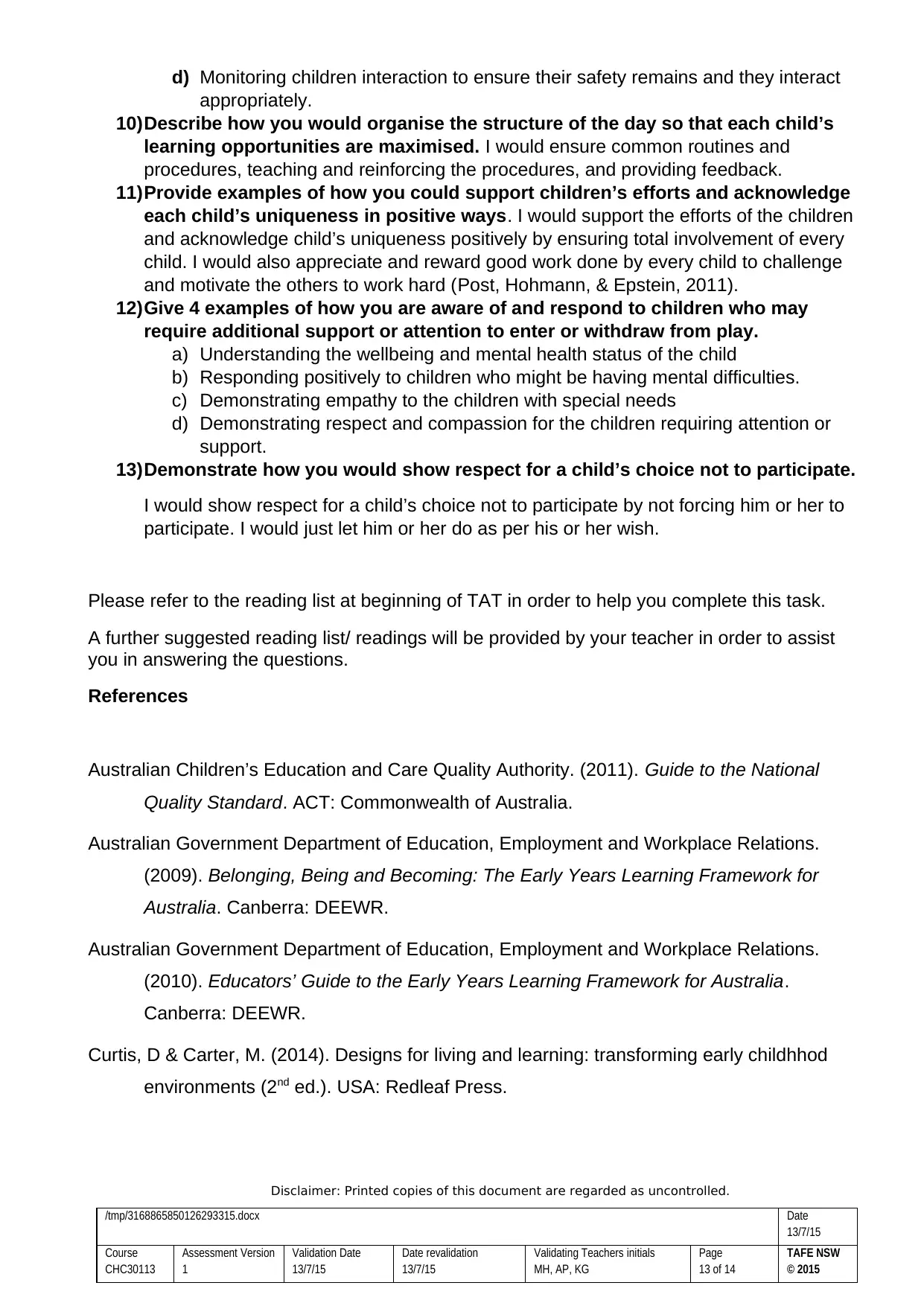
d) Monitoring children interaction to ensure their safety remains and they interact
appropriately.
10)Describe how you would organise the structure of the day so that each child’s
learning opportunities are maximised. I would ensure common routines and
procedures, teaching and reinforcing the procedures, and providing feedback.
11)Provide examples of how you could support children’s efforts and acknowledge
each child’s uniqueness in positive ways. I would support the efforts of the children
and acknowledge child’s uniqueness positively by ensuring total involvement of every
child. I would also appreciate and reward good work done by every child to challenge
and motivate the others to work hard (Post, Hohmann, & Epstein, 2011).
12)Give 4 examples of how you are aware of and respond to children who may
require additional support or attention to enter or withdraw from play.
a) Understanding the wellbeing and mental health status of the child
b) Responding positively to children who might be having mental difficulties.
c) Demonstrating empathy to the children with special needs
d) Demonstrating respect and compassion for the children requiring attention or
support.
13)Demonstrate how you would show respect for a child’s choice not to participate.
I would show respect for a child’s choice not to participate by not forcing him or her to
participate. I would just let him or her do as per his or her wish.
Please refer to the reading list at beginning of TAT in order to help you complete this task.
A further suggested reading list/ readings will be provided by your teacher in order to assist
you in answering the questions.
References
Australian Children’s Education and Care Quality Authority. (2011). Guide to the National
Quality Standard. ACT: Commonwealth of Australia.
Australian Government Department of Education, Employment and Workplace Relations.
(2009). Belonging, Being and Becoming: The Early Years Learning Framework for
Australia. Canberra: DEEWR.
Australian Government Department of Education, Employment and Workplace Relations.
(2010). Educators’ Guide to the Early Years Learning Framework for Australia.
Canberra: DEEWR.
Curtis, D & Carter, M. (2014). Designs for living and learning: transforming early childhhod
environments (2nd ed.). USA: Redleaf Press.
Disclaimer: Printed copies of this document are regarded as uncontrolled.
/tmp/3168865850126293315.docx Date
13/7/15
Course
CHC30113
Assessment Version
1
Validation Date
13/7/15
Date revalidation
13/7/15
Validating Teachers initials
MH, AP, KG
Page
13 of 14
TAFE NSW
© 2015
appropriately.
10)Describe how you would organise the structure of the day so that each child’s
learning opportunities are maximised. I would ensure common routines and
procedures, teaching and reinforcing the procedures, and providing feedback.
11)Provide examples of how you could support children’s efforts and acknowledge
each child’s uniqueness in positive ways. I would support the efforts of the children
and acknowledge child’s uniqueness positively by ensuring total involvement of every
child. I would also appreciate and reward good work done by every child to challenge
and motivate the others to work hard (Post, Hohmann, & Epstein, 2011).
12)Give 4 examples of how you are aware of and respond to children who may
require additional support or attention to enter or withdraw from play.
a) Understanding the wellbeing and mental health status of the child
b) Responding positively to children who might be having mental difficulties.
c) Demonstrating empathy to the children with special needs
d) Demonstrating respect and compassion for the children requiring attention or
support.
13)Demonstrate how you would show respect for a child’s choice not to participate.
I would show respect for a child’s choice not to participate by not forcing him or her to
participate. I would just let him or her do as per his or her wish.
Please refer to the reading list at beginning of TAT in order to help you complete this task.
A further suggested reading list/ readings will be provided by your teacher in order to assist
you in answering the questions.
References
Australian Children’s Education and Care Quality Authority. (2011). Guide to the National
Quality Standard. ACT: Commonwealth of Australia.
Australian Government Department of Education, Employment and Workplace Relations.
(2009). Belonging, Being and Becoming: The Early Years Learning Framework for
Australia. Canberra: DEEWR.
Australian Government Department of Education, Employment and Workplace Relations.
(2010). Educators’ Guide to the Early Years Learning Framework for Australia.
Canberra: DEEWR.
Curtis, D & Carter, M. (2014). Designs for living and learning: transforming early childhhod
environments (2nd ed.). USA: Redleaf Press.
Disclaimer: Printed copies of this document are regarded as uncontrolled.
/tmp/3168865850126293315.docx Date
13/7/15
Course
CHC30113
Assessment Version
1
Validation Date
13/7/15
Date revalidation
13/7/15
Validating Teachers initials
MH, AP, KG
Page
13 of 14
TAFE NSW
© 2015
Paraphrase This Document
Need a fresh take? Get an instant paraphrase of this document with our AI Paraphraser
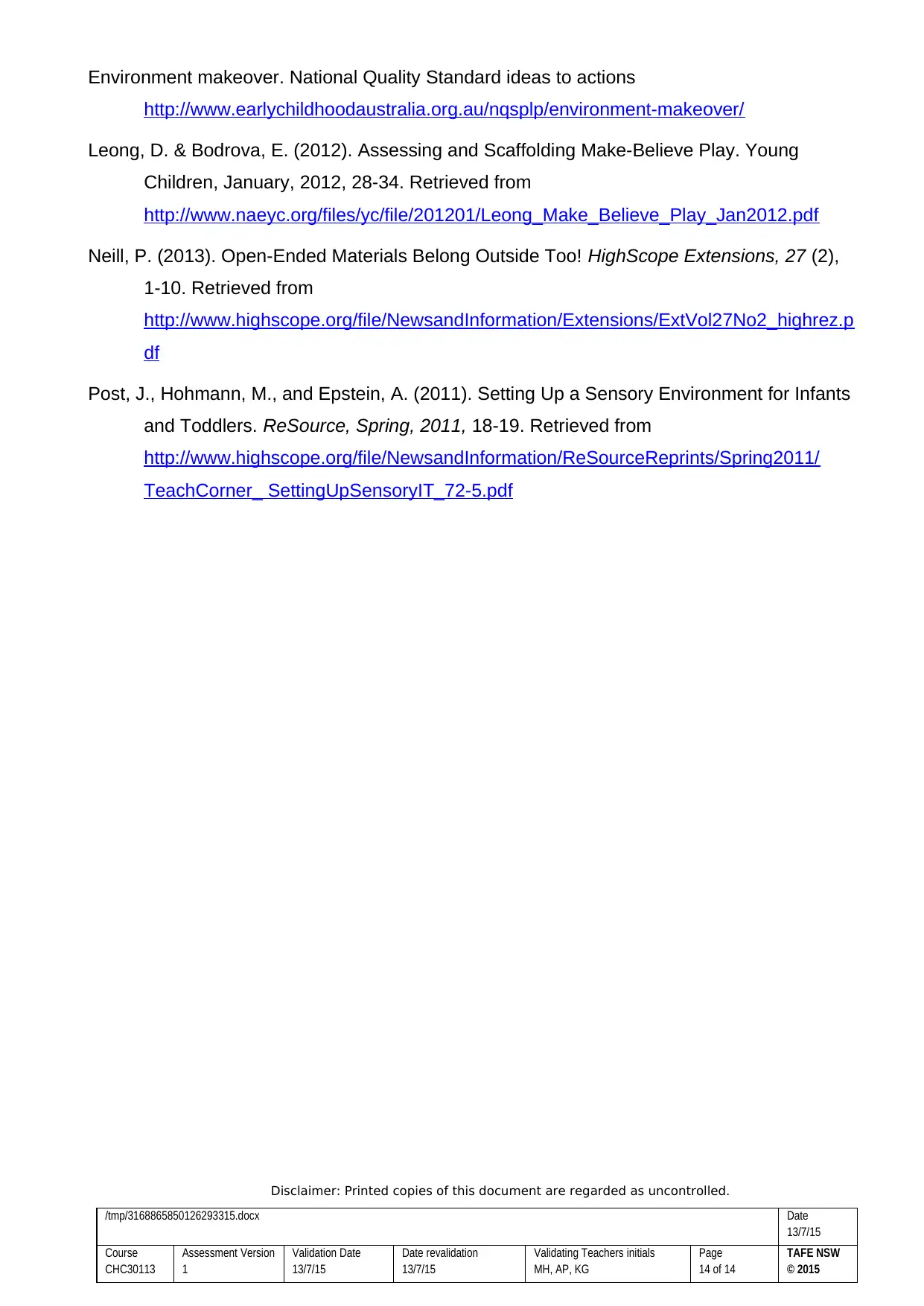
Environment makeover. National Quality Standard ideas to actions
http://www.earlychildhoodaustralia.org.au/nqsplp/environment-makeover/
Leong, D. & Bodrova, E. (2012). Assessing and Scaffolding Make-Believe Play. Young
Children, January, 2012, 28-34. Retrieved from
http://www.naeyc.org/files/yc/file/201201/Leong_Make_Believe_Play_Jan2012.pdf
Neill, P. (2013). Open-Ended Materials Belong Outside Too! HighScope Extensions, 27 (2),
1-10. Retrieved from
http://www.highscope.org/file/NewsandInformation/Extensions/ExtVol27No2_highrez.p
df
Post, J., Hohmann, M., and Epstein, A. (2011). Setting Up a Sensory Environment for Infants
and Toddlers. ReSource, Spring, 2011, 18-19. Retrieved from
http://www.highscope.org/file/NewsandInformation/ReSourceReprints/Spring2011/
TeachCorner_ SettingUpSensoryIT_72-5.pdf
Disclaimer: Printed copies of this document are regarded as uncontrolled.
/tmp/3168865850126293315.docx Date
13/7/15
Course
CHC30113
Assessment Version
1
Validation Date
13/7/15
Date revalidation
13/7/15
Validating Teachers initials
MH, AP, KG
Page
14 of 14
TAFE NSW
© 2015
http://www.earlychildhoodaustralia.org.au/nqsplp/environment-makeover/
Leong, D. & Bodrova, E. (2012). Assessing and Scaffolding Make-Believe Play. Young
Children, January, 2012, 28-34. Retrieved from
http://www.naeyc.org/files/yc/file/201201/Leong_Make_Believe_Play_Jan2012.pdf
Neill, P. (2013). Open-Ended Materials Belong Outside Too! HighScope Extensions, 27 (2),
1-10. Retrieved from
http://www.highscope.org/file/NewsandInformation/Extensions/ExtVol27No2_highrez.p
df
Post, J., Hohmann, M., and Epstein, A. (2011). Setting Up a Sensory Environment for Infants
and Toddlers. ReSource, Spring, 2011, 18-19. Retrieved from
http://www.highscope.org/file/NewsandInformation/ReSourceReprints/Spring2011/
TeachCorner_ SettingUpSensoryIT_72-5.pdf
Disclaimer: Printed copies of this document are regarded as uncontrolled.
/tmp/3168865850126293315.docx Date
13/7/15
Course
CHC30113
Assessment Version
1
Validation Date
13/7/15
Date revalidation
13/7/15
Validating Teachers initials
MH, AP, KG
Page
14 of 14
TAFE NSW
© 2015
1 out of 14
Related Documents
Your All-in-One AI-Powered Toolkit for Academic Success.
+13062052269
info@desklib.com
Available 24*7 on WhatsApp / Email
![[object Object]](/_next/static/media/star-bottom.7253800d.svg)
Unlock your academic potential
© 2024 | Zucol Services PVT LTD | All rights reserved.


